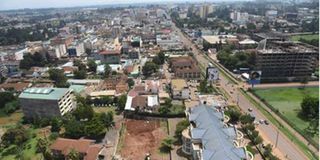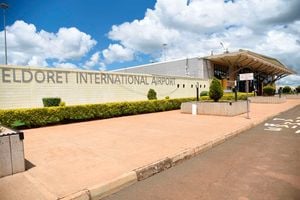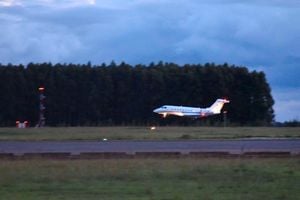
A view of Eldoret town in Uasin Gishu County on July 31, 2024. The town is gearing for elevation to City Status on August 8.
Eldoret is on the cusp of becoming a city, 120 years after it was established as a trading centre by South African Boers who displaced the local inhabitants to create their little town at the corner of Uasin Gishu.
Ironically, Eldoret’s success stemmed from the suppression of African freedoms. In this region, colonialism was fully realised by a group of white settlers who operated with unchecked authority. Eldoret quickly became a center of colonial conflict as local communities, Boers, and British colonists vied for territory. With the support of the British, the Boers forcibly displaced the Maasai to create “breathing space”.
The Maasai and Nandi people suffered greatly, losing the majority of their land to these settlers. As famous American travel writer Negley Farson wrote in his 1947 book Last Chance In Africa, “Eldoret resembled their beloved Transvaal kopjes to the Boers: Here is a land where our women can breed in space”.
Administrative centre
Initially, Eldoret was a modest trading center, comprising a post office, a bar, and a bank. At that time, it was referred to as Farm 64 in government documents until Governor Sir Percy Girouard proposed the name Eldare, believed to be a corruption of the Maasai word “Ngare”, meaning river, in reference to the River Sosiani. Some historians suggest that the name Eldoret resulted from a clerical error in the official gazette on January 1, 1912, and it has remained ever since. The site was chosen as an administrative centre because farmers deemed its soils unsuitable for agriculture, and it was a jungle teeming with hyenas.
Colonial writer Elspeth Huxley, in No Easy Way, describes the Boers’ challenging journey to Eldoret: “To get heavily-loaded wagons up this steep escarpment along the rough, narrow, treacherous track, with inexperienced oxen and in a wet year, was a truly remarkable feat, and only Afrikaners could have performed it.” Today, Eldoret is the capital of agriculture. It has an international airport, a central bank branch, and several universities and campuses. President Moi turned around this town’s fortunes as Nyayo-era homeboys invested their wealth, licit and illicit, into real estate. The town also benefited from Moi’s desire to make Eldoret the seat of his politics — away from Nakuru, where Kenyatta-era politicians had heavily invested.
In Eldoret, Moi decided to build Kenya’s second university rather than in Kenya’s bustling towns of Mombasa and Kisumu. He named it Moi University. He also decided to make an international airport and opened a central bank branch. Pundits then thought that Moi wanted to turn the city into a replica of Gbadolite — the Zaire city that thrived on political patronage. Today, Eldoret has various symbols of the past. There are landmark colonial and independence-era buildings that illustrate how power shifted and how the elite and the rich conceptualised progress.
Eldoret’s growth is partly due to its reputation as a city of champions, being the hub for record-breaking athletes. Home to hundreds of elite athletes, the town has seen a real estate boom. With William Ruto’s rise to the presidency, the city’s prospects are expected to improve further. Eldoret is unique in Kenya, having been founded by South African Boers fleeing British rule after the Anglo-Boer War. The Van Breda brothers — Bon, Dirk, and Piet — were the first Boers to settle in Uasin Gishu in 1903, arriving in 1902 and experimenting with wheat farming. However, conflicts with the local population led to Bon's tragic death.
Prefabricated houses
The significant influx of Boers occurred in 1908 when Frans Arnoldi’s family and 47 other Boer families, approximately 200-300 people, arrived from South Africa. They brought prefabricated houses, wagons, and ploughs, embarking on a trek to the highlands in search of land resembling the velds they had left. Led by Meneer Van Rensburg, this group arrived in Mombasa aboard the German boat “Windhoek” in June 1908 and reached Nakuru on July 18, 1908. Most of them then headed towards modern-day Eldoret with 42 wagons.

A street in Eldoret town, Uasin Gishu County on May 25, 2023.
A legend explains why Eldoret was chosen as an administrative centre. It is said that when the South African farmers reached the site, they were carrying a massive safe in a wagon. When the safe was dropped and could not be reloaded, they decided to build a house around it. Eventually, someone affixed a brass plate inscribed with “Standard Bank of South Africa” on a mud building. A new manager, J.C. Shaw, took charge of deposits and withdrawals, leading to the establishment of a bank.
There was something else about this bank manager: “Mr Shaw used to take his morning bath in a tub behind its counter, and the stroll in his dressing gown to Eddy’s Bar, which had opened up across the way, for a quick one in preparation for the day’s business,” according to Elspeth Huxley, who had visited the early Eldoret. “Eddy provided the town’s water supply by means of an ox cart service from Sosiani river by selling it by the debe – an empty four-gallon petrol tin.”
That is why it is said that Eldoret started with a “bank”, followed by a mud-and-wattle hut housing a post office and a stone rondavel that housed the District Commissioner. Also built was an office and store. The first shop belonged to an Indian trader, Noor Mohammed, while the first lodging was a series of mud and wattle 30 feet by 20 rooms nicknamed “rat pits”. A John Mundell owned these. The Wagon Hotel and New Lincoln Hotel would come later in the 1920s and thrive as leisure symbols in the region. While the Boers had Wagon Wheel, the British settlers loved New Lincoln. As a settler town, the Africans became victims of lawless settlers and lost their land. To date, Eldoret continues to struggle over historical injustices, and many major land cases touch on the failure to undo the colonial mess.
Nightly postal runners
The once vibrant Eldoret post office is credited to John Gosling, who arrived in Kenya from Rhodesia in 1904. In Rhodesia (now Zimbabwe), he introduced a system of nightly postal runners and designed and printed his own stamps. After studying the position of the farms not yet taken up for development, he chose Farm 64 as a central place for a district Post Office. According to Elspeth Huxley, a colonial writer, Eldoret’s struggles changed in 1924 when the railway reached the town. He described the scene in her book, Out on the Midday Sun, “the first train was garlanded with wheat sheaves and bearing the Governor of the day, Sir Robert Coryndon.” In Eldoret, Kenya’s large-scale agriculture commenced, especially wheat and maize. More was to come later. There was also longstanding tension within Eldoret — between whites and Boers and between Africans and all newcomers. However, Eldoret was primarily an Afrikaner town in Kenya with its own Boer church and schools. The Boers built Highland School (now Moi Girls or White Highlands), and the Britons built Hill School.
Another story is that of an Eldoret veteran, Cecil Hoey, who was a breeder of horse races. He once embarked on a safari north of the Nzoia River, lying between Mt Elgon and the Cherangani Hills, to check its suitability as a European settlement. He named the area Trans Nzoia. At a crossing point of Nzoia, he felled trees to make a bridge, and for many years, this was known as Hoey’s Bridge until Moi renamed it Moi’s Bridge.
The first church appeared in Eldoret in 1920, thanks to Rev O.H. Knight, who had spent 15 years in Japan. The Boers built their house in today’s Eldoret Club and held services in parishioners’ houses. The Boers also built the Emanuel Dutch Reformed Church, whose pioneer preacher was the grandfather of former South African president Frederick de Klerk.
Another fascinating story about Eldoret is that it was the only town with an unmanned bar where revellers could freely walk in, take their beer, and leave money on the counter. The story goes that two thirsty patrons found the bar padlocked and broke the door. From then on, it operated without a door — and on the goodwill of clients. As it becomes a city, Eldoret will have to renew the goodwill of an age long gone. It is one of Kenya’s most cosmopolitan towns and has a unique history.








